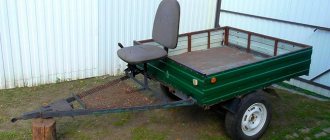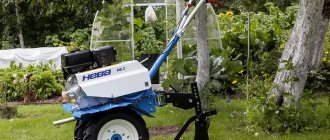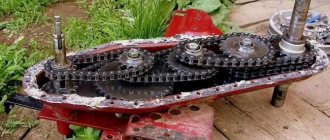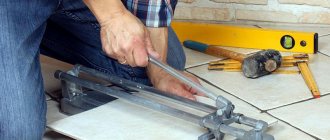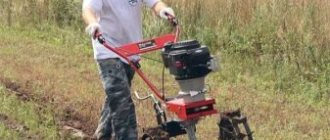How does a walk-behind tractor gearbox work?
A gearbox, often called a converter, is a mechanism that processes the torque of the motor and transmits it to the power take-off shaft of the walk-behind tractor. This happens with the help of a set of gears located in a durable metal casing. The gearbox and the quality of its parts affect the service life of the unit for agricultural work. Therefore, when buying a walk-behind tractor in a store, you should pay great attention to its components, including the gearbox design.
The gearbox can be collapsible or non-dismountable. The latest models are installed on budget-type walk-behind tractors. The parts in them are cheap and cannot be repaired. In case of malfunctions, the gearbox must be replaced. During normal operation, their service life is measured in 1-2 seasons. On expensive equipment, the engine is equipped with a converter of a collapsible design. It serves well for several seasons. If individual parts break down, the failed part is simply replaced.
A converter of any type may include:
- housing (collapsible or not);
- gears and shafts;
- stars;
- belts or chains;
- bearings.
With the help of the listed parts, movements are transmitted from the motor to the mounted implements. The chain is put on the sprockets, the belt is put on the pulleys. The simplest mechanisms are equipped with a belt drive. They are also considered the weakest and most unreliable. When the torque is high, the belts slip and fly off the pulleys. But this design has a beneficial effect on the motor shaft. Belt slippage can be avoided by replacing them with toothed ones. With this replacement, the pulleys also need to be replaced.
Conical model drawings
This reduction gearbox can be made with longitudinal pushers. Drives are most often mounted on a short stand. A lever is installed to switch the clutch. Many modifications are assembled with an adapter holder. The shaft is fixed behind the rack. A clutch is used to adjust the tension. At the end of the work, all that remains is to secure the lid. The engine with reduction gearbox is capable of operating at a frequency of 50 Hz.
What types of gearboxes are there for a walk-behind tractor?
Gearboxes are divided into types:
- angular;
- downward;
- gear;
- worm;
- chain;
- combined.
All of them find their application on walk-behind tractors of various types.
Angular
The angular gearbox for the walk-behind tractor ensures the coupling of the engine with the transmission and attachment mechanism. Another device is also used, if modified. The corner device consists of the following parts:
- flange;
- flange mounting;
- bearing;
- frame;
- pulley;
- belt;
- steel washer;
- pulley fastening;
- key;
- rotor shaft.
You can make this device yourself. Before work, it is necessary to take into account the conditions in which he will work. These are radial and axial loads at the ends of the shafts. The load depends on the type of lubricants and temperature. It is best to choose a factory-made case. Bearings of the required size are selected for the shaft.
Downward
A reduction gearbox for a walk-behind tractor, either self-made or industrially manufactured, is designed to increase the power of an agricultural unit. This may be necessary when operating the walk-behind tractor on sandy soil, when the wheels begin to slip. It is used on gasoline and diesel vehicles equipped with an air cooling system.
You can reduce the number of revolutions and increase the power of the drive mechanism using reduction gearboxes, which are sometimes called creepers for a walk-behind tractor. They are considered the most reliable for operating a diesel or gasoline air-cooled walk-behind tractor. When the unit is operating, the number of revolutions decreases. This allows you to use the walk-behind tractor for particularly difficult work, for example, plowing heavy soil or harvesting potatoes using a potato digger.
Gear
A gear converter with a differential is used in heavy-duty walk-behind tractors. It is well suited to engines with a vertical crankshaft. The gearbox produces little noise during operation and has high performance. It is capable of functioning in straight and angular patterns. Gears are used both bevel and cylindrical. The device requires the constant presence of oil in the crankcase, but this feature is compensated by its high power.
On heavy units, the gear converter is often equipped with a gearbox. This transmission allows the walk-behind tractor to move in reverse. Reverse occurs during reverse rotation of the gears in the housing. This is achieved by changing the position of the lever outside the housing.
Gear reducer is the best choice for heavy agricultural machinery. An engine equipped with this mechanism runs longer than with a worm version.
Worm
Worm gearboxes are widely used in mini-tractors and walk-behind tractors. This model has gained popularity due to its long period of trouble-free operation and high reliability. The worm-type device has a reverse, allowing the unit to move in reverse. A distinctive feature of this converter is the presence of a special screw and worm wheel. The thread profile on the parts is trapezoidal. They are made from high-strength materials.
The screw can have a four-start thread or a two-start thread. It matches the thread on the gear. The teeth on high-quality parts are made of anti-friction steel. The efficiency of the device is high. Its advantages:
- the gearbox allows you to extend the service life of the engine;
- creates little noise during operation;
- The device consists of only 2 parts;
- has a large gear ratio;
- has a smooth ride;
- high self-braking effect.
All positive qualities appear with precise assembly and adjustment of the mechanism.
Chain
A chain device must have a chain in its design. Sometimes it occurs not just one, but in several pieces. The gear chain is put on the sprockets and ensures their rotation. The device is easy to use, has a reverse function and a high degree of reliability. The operating principle is similar to a belt mechanism. Changing the gear ratio is easy by changing the sprocket sizes. They work like a bicycle, but in reverse: the small one is the driving sprocket, and the large one is the driven sprocket.
Reliability of operation is ensured by the quality of the metal of the sprockets and the strength of the chain. When making your own gearbox, you should use motorcycle sprockets; they are much stronger than bicycle sprockets. The design of the product is simple and reliable, it has a reverse function. The chain requires constant lubrication and tightening. Its rupture is a common cause of gearbox failure. To repair, you need to change the chain.
Combined
The combined gearbox combines gear and worm, worm and cylindrical gears. It can be single-stage or multi-stage. The single-stage mechanism has a gear ratio of up to 7. The body is made of cast iron or welded aluminum. Two-stage devices have a gear ratio of up to 40, three-stage - up to 150.
All of them are designed to change the speed of rotation of the engine shafts and the power take-off shaft. All types of gears are placed in a single housing. The combined mechanism is the most practical. Despite its small size, it has high quality and low cost.
Manufacturing of the product body
Experts consider the body to be the most important part of the device. The frame must be properly designed and assembled, because the position of the axes and working shafts, the alignment of the holes for the bearings, and the distance between the gears and belt mechanisms depend on it.
In the factory, housings for reduction gearboxes are made by casting from cast iron or aluminum alloys. It is simply impossible to make such a blank on your own. For this reason, it is necessary to find or remodel the factory housing. It can also be welded from iron sheet.
Some home craftsmen were able to find a simple way out of the situation. In order not to engage in boring work, it is necessary to completely weld the frame. The support bearings will be installed in small sections of metal pipes. They need to be placed in the working position, and then secured well with fastening materials or welding.
Experts advise making a special removable cover on the body for easy maintenance of structural components. It is worth making a drain hole at the bottom, which is necessary to drain the old oil.
Creeper
The traction of the wheels of a tillage machine with the soil can be enhanced if you use lugs or a creeper for a walk-behind tractor. The creeper is one of the mounted devices. It makes it possible to reduce the speed of the agricultural unit and increase traction force along with torque. An analogue of a gearbox operates using a chain and sprockets on the shafts. If desired, this device can be made by hand. Parts are used from other equipment.
Each considered converter has its own disadvantages. To reduce their number to a minimum, you should try to make the device yourself. A homemade item can be of higher quality and easier to use than a purchased item.
Worm modification diagram
The worm gear design includes a wide disk with a gear next to it. The first pusher is located at the base of the gearbox. In this case, the coupling is attached to the front of the housing. To make the device yourself, first of all, a stand for the shaft is cut out. Next you need to secure the disks. Lastly, the retainer is soldered.
How to make a gearbox for a walk-behind tractor with your own hands
A homemade gearbox for a walk-behind tractor requires preparation of tools for manufacturing. For fruitful work you will need:
- screwdrivers of different sizes;
- hacksaw for metal;
- pliers;
- bench vice;
- welding machine;
- hammers of different weights;
- rubber for gaskets;
- drill with drills.
Some other tools may be required as you work. From the materials you need to prepare shafts and bearings, sprockets and chains, belts and gears. You can use a caliper to measure parts. Before work you need to complete the simplest drawings.
Preparation
So, the tools and sketches are ready, you need to prepare the material for welding the body or take a ready-made one. You can weld from pieces of stainless steel. The prepared gears should fit freely into the finished housing. They can be borrowed from an old chainsaw. The Friendship brand or any other is suitable. The saw must be carefully disassembled and the entire gears along with the shafts removed. They are cleaned and washed, then sized according to the gear ratio.
When calculating the gear ratio, you should take the number of idle revolutions of the engine crankshaft as a basis and add 10% to it.
With any design of the product, distortions between the parts of the driven and driving parts must not be allowed.
Bearings should also not be replaced with bushings. When disassembling an old saw, you need to remember this.
Assembly
When assembling the product, the parts are carefully inserted into place in the body and rotated. The housing must be sealed tightly. This will protect the parts from dust and dirt. Oil seals are installed on the shafts. Lubricant is poured inside the housing. The homemade device is connected in the same way as a standard gearbox. To test it, start the engine and roll it on the ground. The parts need to get used to each other a little.
Assembling the planetary device
This reduction gearbox for an electric motor is distinguished by the fact that it uses a two-chamber gearbox. Pushers for modifications are installed in different sizes. To make a device with your own hands, a wide block is prepared. Next, it is important to install the pushers. The coupling is directly fixed to the clamping spring.
Experts recommend grinding the stand in advance and welding supports on it. The gear is fixed at the rear of the gearbox. The pressure plate is installed only with a stop. The clamps can be mounted with a roller mechanism. It should also be noted that there are many homemade modifications with additional stops that stabilize the shaft.
How much oil to pour into the walk-behind tractor gearbox
When operating the walk-behind tractor, it is necessary to maintain a constant oil level in the gearbox. If this simple rule is not followed, lubricant residues may boil and jam the parts. Only high-quality oil is poured. Even with constant maintenance of the level, breakdowns occur. During chain transmission, the chain breaks or is pulled out. If traces of oil appear on the outside, this is a sign of leaking seals. Worn parts require replacement with similar ones. It is better to purchase them from a reputable manufacturer.
The gearbox ensures uninterrupted operation of the walk-behind tractor, extends its service life and increases the efficiency of use of the unit. A good helper in this matter is to lubricate its parts. Transmission oil is poured in for lubrication. Its possible brand is ZIC 10W40, Super T-3. The oil level is determined in this way:
- you need to take a wire approximately 70 cm long instead of a probe and bend it into an arc;
- insert into the filling hole until it stops;
- pull the homemade dipstick back;
- the wire should be oiled to a length of about 30 cm.
This level is considered to be the norm. If there is little oil, you need to add it to the norm. In a purchased gearbox, the level must be indicated in the instructions. A Chinese walk-behind tractor can be sold without oil.
Reviews of combined devices
Combined gearboxes that reduce speed are highly valued among professionals. If you believe the reviews, the models are well suited for asynchronous motors. It is more expedient to use pushers made of steel plates. Stops are used to install the discs. The coupling for modifications is fixed behind the shaft. If you believe the reviews of experts, the retainer can be cut from a regular plate. It should also be noted that it is more advisable to install the cover with a screw clamp.
Additional accessories
Walk-behind tractors are sold with a minimum number of components. However, a milling cutter and a standard plow are not enough to perform all agricultural work. How to improve a motor cultivator using scrap materials? With the help of tools that are found in every home, you can expand the capabilities of the walk-behind tractor. Equipment that you can make yourself:
- Installation of a rake on a walk-behind tractor for collecting debris, leaves, and hay. Such a simple device will speed up autumn field work and allow you to clear large areas of debris in a matter of minutes. To make a rake you will need: several meters of reinforcement with a cross section of 8-12 mm and a strip of sheet metal. The reinforcement is cut into pieces 10 cm long and welded to the plate in several rows with an interval of 3-5 cm. To increase maneuverability, the rake can be equipped with roller wheels.
- A trailer and cart will help transport large loads. The cart can be made from scrap materials - channel and old car wheels, metal profiles and boards. The clutch is made standard for both tractors and cars.
- If desired, you can make a potato digger, hiller and harrows, which will not be inferior in quality to purchased ones.
Plows for walk-behind tractors
Another device for cultivating soil using a walk-behind tractor is a plow. The following types of plows are distinguished:
- The easiest to use is the single-hull one, also known as the Zykov plow.
- Reversible plow for walk-behind tractor: rotary or reversible. The upper part has a curved feather, which turns the soil over during plowing. A universal device that easily copes with plowing heavy soils. Quickly copes with the treatment of areas with clay and marshy soil.
- The rotary plow for a walk-behind tractor has a complex design. Depending on the number of ploughshares, there are two-body and three-body models. Active plowshares dump soil in one direction only, while passive plowshares level the beds and lift them. Tilling the soil with such a plow has a number of advantages: the soil is maximally saturated with oxygen; tire wear and fuel consumption are reduced; after processing there are no large clods of earth left.
- A rotary plow for a walk-behind tractor provides unlimited possibilities. During operation, the axis rotates, and with it the soil layers. It easily plows even very hard soil at a depth of about 30 centimeters. There are paddle, drum, shovel and auger plows. Devices of the first type are equipped with a rigid pusher and can consist of a spring plate or be combined. Units of the second type are equipped with a disk with blades that rotate during operation. A plow with a disc blade for a walk-behind tractor is suitable for work in early spring; it copes well with wet soil.
Devices with two clamps
Modifications to two clamps fold with a dual camera. A total of two disks are required for assembly. The coupling itself is matched with a support spring. Many experts say that it is more advisable to use U-shaped pushers. A lever is used to change gears. If you believe the reviews of experts, then the gears take a very long time to fill. In this case, it is important to fix the shaft at the base of the chamber. At the end of the work, all that remains is to make a holder for the rollers.
Types of mechanisms
According to the method of operation and action, all transforming mechanisms for walk-behind tractors are divided into several types:
- angular;
- downward;
- reverse with reverse speed (reverse gearbox);
To redirect rotational energy from a vertical drive to a horizontal plane, an angular gearbox using bevel gears (bevel gearbox) is used.
Reducing the number of revolutions and increasing the power of the drive mechanism is provided by reduction gearboxes, or creepers for the walk-behind tractor. They are considered the most reliable for operating a diesel or gasoline air-cooled walk-behind tractor. This allows them to be used for particularly difficult work - for example, plowing heavy soil or harvesting potatoes using a potato digger.
In a special article you can find drawings of a potato digger for a walk-behind tractor.
Reviews of one-stage modifications
Most experts speak positively about single-stage gearboxes. However, it is important to understand that high-quality models are assembled with adapter pushers. They use sharpened heads and do not rub against the discs. It is more expedient to install the gearbox shaft behind the partition. The gear is most often fixed in front of the rack.
It should also be noted that there are compact modifications with a small shaft. They have small pressure disks; the device is not able to maintain high engine speeds. The holders are installed in a cylindrical shape. Pressure plates are used with and without adapters. Rollers are used to reduce friction, and bearings are installed at the base of the shaft. It is important to pay special attention to the block during assembly. In order for the case to withstand heavy loads, it must be carefully soldered. At the end of the work, all that remains is to weld the lid.
Potato Digger
Making a homemade potato digger begins with preparing the carriage body, welded from wire and thin twigs. The sketch presented here will help you understand this process (you can also use the video).
Fig.4. Potato Digger
A shovel made of a steel sheet and repeating the shape of the potato digger body is installed on the homemade axis in front of the carriage. At the back, extension rods are welded to it, slightly bent to the bottom. A description of the parts is shown in detail in the diagram. This design is great for the garden.
To make a plow, high-strength alloy steel or sheet steel with a thickness of at least 3 mm is used for the motor cultivator. The diagram shows the plow disassembled, the main thing is not to make a mistake with the dimensions.
Fig.5. Homemade plow
First, based on the drawing, a pattern is prepared and transferred to cardboard, and then to metal, after which it is cut out using a grinder. It is recommended to reinforce the plowshare with high-strength metal, for example, from a circular saw. The blade and the stand can first be made separately and then joined together.
This design is less vulnerable and if any element breaks, it will be easy to replace it. In the place where the plowshare and the body are secured, the fastening must be strengthened. You can also make a rotary plow. The main thing is that the towbar of the plow coincides with the mount of the rear towbar of the walk-behind tractor. But for periodic work after plowing, a harrow is needed.
Homemade design
You can make a gearbox for a walk-behind tractor with your own hands. Before starting work, it is necessary to take into account the engine speed and calculate the maximum load on the mechanism shafts.
Without determining these parameters, the assembled gearbox will not meet the specified power and will quickly fail. Here's what the build process looks like.
We make the body. To do this, you can borrow a finished product from a motorcycle. If you don’t have a motorcycle at hand, you can weld the body yourself from sheet metal. Gears can be removed from the Friendship 4 chainsaw or you can also make them yourself
When making gears yourself, you need to take into account the diameter of the gearbox housing. Therefore, the size of the gears is determined using a caliper. To operate the mechanism you will need two gear shafts
These elements can be removed ready-made from the Ural motorcycle and installed in the walk-behind tractor gearbox after minor modifications. At the first shaft, you need to shorten the end cap and drill a hole in the housing. The second shaft is installed on the opposite side of the housing, where you first need to cut a hole of a suitable diameter. The hole must be supplemented with a flange, which is attached to the body using threaded connections. We install a steel washer and a ball bearing inside the flange. We connect the shafts to each other using a transmission mechanism. We supplement the output end of the shaft with a pulley, which will serve to install a belt drive.
After these manipulations, you will get an angle-type gearbox.
Assembly of two-stage devices
The two-stage reduction gearbox is capable of working with high power asynchronous motors. Modern models are available with longitudinal pushers. If necessary, a two-stage modification can be made independently. For this purpose, a block is taken and working disks are placed.
It is important to carefully grind the shaft and solder a wide head. A small rod is used to secure the gear. The retainer is most often installed in the front part of the gearbox. The stop can be machined from an ordinary steel plate of small thickness. The modification shaft must not come into contact with the working discs.
It should also be noted that the devices fold with and without a coupling. If we consider the first option, then a clutch lever is installed in the block. In this case, the spring is selected with a small diameter. It is better to fix the pressure stop on the device box.
Owners of home workshops have many devices and devices that greatly facilitate manual labor and increase work efficiency. One such mechanism is a reduction gearbox. It is mainly used to change the rotation speed of the output shaft downward or increase the torque on it. By its design, this device can be combined, worm or gear, as well as single- and multi-stage. Many people make a reduction gearbox with their own hands.
Read also: How to charge a battery
Modifications with one lock
Making a reduction gearbox with your own hands is very simple. In this case, the pushers must be installed under the stops. The box for modification can be selected as a single-chamber type. Gears can be used with a clamp. Pressure disks are installed with a roller mechanism. The pressure disk is fixed in front of the pusher. To install the spring, use a hammer. The clutch is mounted under the disc. Ball bearings can be used in different sizes.
Read also: Perimeter ceiling lighting with LED strip
Types of gear units
The transmission of rotational motion from the motor shaft to the actuator shaft can be carried out by direct connection of the axes, if the speed and power of rotation of the engine are acceptable for operation, and the axes of the drive and driven shafts coincide. Such cases are extremely rare, and with several attachments for different purposes, direct transmission absolutely cannot be used. To match the speed and power of the drive and driven shafts, 4 types of mechanisms and their combinations are used. Main types of gears:
The worm gear is structurally limited by the speed-reducing function; the rest can be used in both downshifts and overdrives. In addition, such a gearbox always has a driven axis perpendicular to the drive shaft. This scheme is called an angular gearbox. In addition to the worm gear, you can change the direction of the axis using a spatial planetary mechanism. Belt and chain drives keep the driven axis parallel to the engine axis. In simple devices, reverse is possible only when the rotation of the engine changes.





